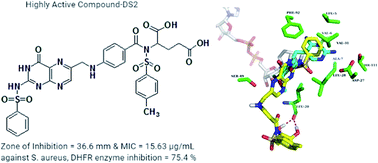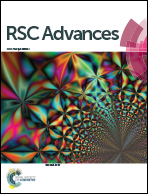Folic acid-sulfonamide conjugates as antibacterial agents: design, synthesis and molecular docking studies†
Abstract
Dihydrofolate reductase (DHFR) inhibitors, as antibacterial agents, contain pyrimidine, pteridine, and azine moieties among many other scaffolds. Folic acid (FA), with a pteridine ring and amine group, was used as our focus scaffold, which was then conjugated with sulfonamides to develop new conjugates. The novel synthesized conjugates were characterized using infrared spectroscopy, and 1H and 13C nuclear magnetic resonance (NMR) spectral studies and consequently screened for antimicrobial activities against bacterial strains with ampicillin as a positive control. Compound DS2 has the highest zone of inhibition (36.6 mm) with a percentage activity index (%AI) value of 122.8% against S. aureus and a minimum inhibitory concentration (MIC) of 15.63 μg mL−1. DHFR enzyme inhibition was also evaluated using the synthesized conjugates through in vitro studies, and inhibition assays revealed that compound DS2 exhibited a 75.4 ± 0.12% (mean ± standard error of the mean (SEM)) inhibition, which is comparable with the standard DHFR inhibitor trimethoprim (74.6 ± 0.09%). The compounds attached to the unsubstituted aryl moiety of the sulfonamides revealed better inhibition against the bacterial strains as compared to the methyl substituted aryl sulfonamides. Molecular docking studies of the novel synthesized conjugates were also performed on the DHFR enzyme to identify the plausible binding modes to explore the binding mechanisms of these conjugates.

- This article is part of the themed collection: 2020 RSC Advances HOT Article Collection


 Please wait while we load your content...
Please wait while we load your content...